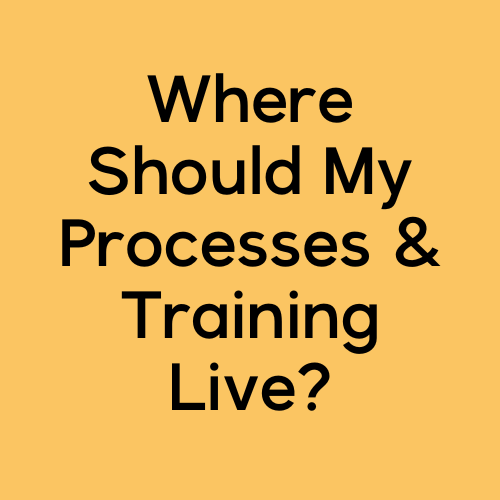The 3 Pillars of Good (Enough) Process
The best process is the one that gets done.
Not the one most eloquently stated.
Not the one that’s newest.
Or—GASP—the one more efficient than any other process that ever lived.
From Shaved Ice to Selling Expertise, Part 2/3
How to transition from selling a product customers can see, touch, and taste to selling expertise.
From Shaved Ice to Selling Expertise,Part 1/3
How to transition from selling a product customers can see, touch, and taste to selling expertise.
Where Should My Processes & Training Live?
Where Should My Processes & Training Live? A Comparative Guide to Trainual, Playbook Builder, and Notion
How to Uncomplicate Documenting What You Do
Why does documenting what you do feel so complicated?
The honest answer? You’re just too good at what you do.
You now know your business at an expert level. You go through each routine without skipping a beat. It comes naturally. And you’re really good at it. However, this makes documenting what you do hard.
Just How Detailed Should My Standard Operating Procedures Be?
While many business leaders understand why process documentation matters, most are also unsure about which details they should—or should not—include.
So which details matter? And which ones don’t? Here are 5 questions to help you decide for yourself.
The Ultimate Guide to Employee Experience
Just like strategy, consulting, and culture, the term employee experience is often perceived as vague at best, and frivolous at worst.
You may be asking: What exactly is it, and why do I need one?
Korn Ferry reports that organizations double profitability when they improve their employee experience. Gallup calls “untapped human capital” the next great global resource. That’s why employee experience has been called the next competitive frontier in business.
In this piece, we take a comprehensive look at what employee experience (or EX) really is, why it matters, and how it impacts your bottom line - whether you have 10 employees, or 10,000.
Using SOPs to Scale Your Business
According to the U.S. Bureau of Labor Statistics, roughly 20% of new businesses fail in their first two years; 45% in their first five; and 65% in their first 10. Only 25% of new businesses make it to 15 years or more.
Assuming they sell a viable product or service, it’s usually one of two reasons: 1) they run out of money, or 2) they manage employees poorly.
Of the businesses that do survive the 5-, 10- or 15-year mark, many never grow to the size that generates lucrative owner salaries and profits.
What is an SOP?
You started your business to have more freedom, to make more money, and to leave a legacy. But now you’re CEO, Head of Sales, and Director of HR all rolled into one.
What will it take to get off the treadmill?
Whether you have 1 employee or 100, defining and documenting your standard operating procedures (SOPs) is the answer.
3 Employee SOPs You Didn’t Know You Needed
This post originally appeared on the Trainual blog.
No business is successful without great people — that’s a given.
But not every business owner is in-the-know on how to systemize & scale a great employee experience.
Here are 3 things every entrepreneur needs to systemize to hire and keep the best talent:
Your EVP (employee value proposition)
Your employee surprise & delight strategy
Your offboarding process
Read more at Trainual: 3 Employee-Related Processes You Didn’t Know You Needed











